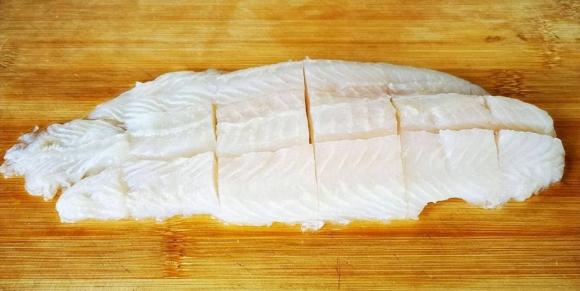Swai fish, also known as basa fish, is a type of freshwater, boneless fish with tender, flavorful, and highly nutritious meat. It is rich in protein, vitamin A, minerals, and amino acids, among other essential nutrients. Regular consumption of swai fish offers numerous health benefits.
Swai fish is commonly sold in markets and supermarkets at affordable prices, and it can be prepared in a variety of ways. One of the simplest and most nutritious ways to cook swai fish is by steaming it. This method of preparation enhances the natural sweetness of the fish while retaining its moisture and tenderness.
Ingredients:
– Swai fish
– Cooking wine
– Pepper
– Vinegar
– Soy sauce
– Dark soy sauce
– Salt
– Sesame oil
– Scallions
– Dried chili peppers
– Carrots

Swai Fish
Instructions:
Step 1: Clean the swai fish and cut it into small pieces, approximately 3 cm in length. Place the fish in a large bowl and add 1 tablespoon of cooking wine to remove any fishy smell. Add a pinch of pepper and mix well. Marinate for 15 minutes.
Step 2: In a separate bowl, prepare the sauce by mixing 2 tablespoons of vinegar, 1 tablespoon each of soy sauce and dark soy sauce, a pinch of salt, and sesame oil to taste. Add finely chopped garlic and mix well.
Step 3: Place the marinated swai fish in a heat-proof dish and pour the prepared sauce over it. Top with chopped scallions, dried chili peppers, and carrots.
Step 4: Place the dish in a steamer and steam over medium heat for about 20 minutes. Serve and enjoy!
Steamed swai fish is a delicious and healthy dish that is low in fat and calories. The fish turns out tender and flavorful, absorbing the essence of the spices and sauces.

Steamed Swai Fish
Other Delicious Swai Fish Recipes:
Grilled Swai Fish in Foil
Grilled swai fish cooked in foil is an easy and flavorful dish. The sweet and tender fish absorbs the flavors of the spices and herbs, and when paired with peanut sauce and scallion oil, it creates a harmonious and mouthwatering combination. Serve it with rice paper, fresh herbs, and rice vermicelli, along with a sweet and sour dipping sauce.
Swai Fish Fried with Lemongrass and Chili
Marinated swai fish is fried with lemongrass and chili, resulting in a crispy and aromatic dish. The fish is tender and flavorful, with a spicy kick and a distinctive lemongrass fragrance.
Swai Fish in Caramel Sauce
Swai fish cooked in caramel sauce is a quick and easy dish that packs a punch of flavor. The fish remains moist and tender, with a crispy exterior soaked in a savory-sweet sauce. It goes well with rice or rice noodles.

Swai Fish in Caramel Sauce
Swai Fish Cooked with Fermented Rice
A unique and tasty dish, swai fish cooked with fermented rice has a distinctive aroma and flavor. The soup has a characteristic white color and a tangy taste, and the addition of plantains gives it a subtle bitterness, creating a well-balanced and addictive meal.

































